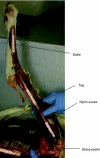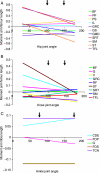Functional anatomy and muscle moment arms of the pelvic limb of an elite sprinting athlete: the racing greyhound (Canis familiaris)
- PMID: 18657259
- PMCID: PMC2644771
- DOI: 10.1111/j.1469-7580.2008.00961.x
Functional anatomy and muscle moment arms of the pelvic limb of an elite sprinting athlete: the racing greyhound (Canis familiaris)
Abstract
We provide quantitative anatomical data on the muscle-tendon architecture and geometry of the pelvic limb of an elite sprint athlete, the racing greyhound. Specifically, muscle masses, muscle lengths, fascicle lengths, pennation angles and muscle moment arms were measured. Maximum isometric force and power of muscles, the maximum muscle torque at joints and tendon stress and strain were estimated. We compare data with that published for a generalized breed of canid, and other cursorial mammals such as the horse and hare. The pelvic limb of the racing greyhound had a relatively large volume of hip extensor muscle, which is likely to be required for power production. Per unit body mass, some pelvic limb muscles were relatively larger than those in less specialized canines, and many hip extensor muscles had longer fascicle lengths. It was estimated that substantial extensor moments could be created about the tarsus and hip of the greyhound allowing high power output and potential for rapid acceleration. The racing greyhound hence possesses substantial specializations for enhanced sprint performance.
Figures









Similar articles
-
Functional anatomy and muscle moment arms of the thoracic limb of an elite sprinting athlete: the racing greyhound (Canis familiaris).J Anat. 2008 Oct;213(4):373-82. doi: 10.1111/j.1469-7580.2008.00962.x. J Anat. 2008. PMID: 19034998 Free PMC article.
-
Functional specialisation of the pelvic limb of the hare (Lepus europeus).J Anat. 2007 Apr;210(4):472-90. doi: 10.1111/j.1469-7580.2007.00704.x. Epub 2007 Mar 15. J Anat. 2007. PMID: 17362487 Free PMC article.
-
Functional specialisation of the thoracic limb of the hare (Lepus europeus).J Anat. 2007 Apr;210(4):491-505. doi: 10.1111/j.1469-7580.2007.00703.x. J Anat. 2007. PMID: 17428206 Free PMC article.
-
Contributions to the understanding of gait control.Dan Med J. 2014 Apr;61(4):B4823. Dan Med J. 2014. PMID: 24814597 Review.
-
How musculotendon architecture and joint geometry affect the capacity of muscles to move and exert force on objects: a review with application to arm and forearm tendon transfer design.J Hand Surg Am. 1992 Sep;17(5):799-804. doi: 10.1016/0363-5023(92)90445-u. J Hand Surg Am. 1992. PMID: 1401783 Review.
Cited by
-
The advantage of standing up to fight and the evolution of habitual bipedalism in hominins.PLoS One. 2011;6(5):e19630. doi: 10.1371/journal.pone.0019630. Epub 2011 May 18. PLoS One. 2011. PMID: 21611167 Free PMC article.
-
From fibre to function: are we accurately representing muscle architecture and performance?Biol Rev Camb Philos Soc. 2022 Aug;97(4):1640-1676. doi: 10.1111/brv.12856. Epub 2022 Apr 7. Biol Rev Camb Philos Soc. 2022. PMID: 35388613 Free PMC article. Review.
-
In vivo human lower limb muscle architecture dataset obtained using diffusion tensor imaging.PLoS One. 2019 Oct 15;14(10):e0223531. doi: 10.1371/journal.pone.0223531. eCollection 2019. PLoS One. 2019. PMID: 31613899 Free PMC article.
-
Mechanical constraints on the functional morphology of the gibbon hind limb.J Anat. 2009 Oct;215(4):383-400. doi: 10.1111/j.1469-7580.2009.01123.x. Epub 2009 Jul 15. J Anat. 2009. PMID: 19627388 Free PMC article.
-
Hip medial rotator action of gluteus medius in Japanese macaque (Macaca fuscata) and implications to adaptive significance for quadrupedal walking in primates.J Anat. 2022 Aug;241(2):407-419. doi: 10.1111/joa.13658. Epub 2022 Mar 31. J Anat. 2022. PMID: 35357010 Free PMC article.
References
-
- Abe T, Kumagai K, Brechue WF. Fascicle length of leg muscles is greater in sprinters than distance runners. Med Sci Sports Exerc. 2000;32:1125–1129. - PubMed
-
- Alexander RM, Jayes AS, Maloiy GM, Wathuta E. Allometry of the leg muscles of mammals. J Zool Lond Series A. 1981;194:227–267.
-
- Ameredes BT, Brechue WF, Andrew GM, Stainsby WN. Force-velocity shifts with repetitive isometric and isotonic contractions of canine gastrocnemius in situ. J Appl Physiol. 1992;73:2105–2111. - PubMed
Publication types
MeSH terms
LinkOut - more resources
Full Text Sources
Miscellaneous

